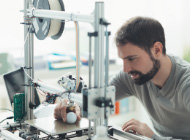
3D printing is definitely an easy and fast way to produce good quality prototypes and consumer items nowadays. However, this process can be time-consuming and challenging especially when designers and engineers encountered some 3D printing problems.
Some 3D printing issues are easy to troubleshoot. Nevertheless, there are also some problems that require some effort and time to diagnose so they can be solved. To help designers and engineers, here is a blog post on how to resolve the most common 3D printer failures.
Nozzle too close to print bed
When there is no filament deposited on the print bed, check the 3D printer again because the nozzle may be too close to the print bed.
If the print bed is tuned to mere microns from the nozzle opening, then the melted filament is unlikely to escape. As a result, the melted filament in the hot end will possibly cause a blockage.
To solve this issue, just slightly raise the height of the nozzle. For 3D printers, its system settings will allow setting a Z-axis offset. Thus, the offset must be adjusted into a positive value to raise the nozzle away from the print bed. Just make sure it is not too high of an offset so that the prints won’t stick to the platform.
Blocked nozzle
When nothing comes out of the nozzle during a print job, the nozzle may be blocked. This problem may be caused by a small piece of filament that has been left behind in the nozzle.
This scenario happens after changing spools where a filament has snapped off at the end. Whenever a new filament is loaded, the old filament that is left in the nozzle will not allow the new one to push through.
To avoid this, give the 3D printer a little maintenance check before starting a new print job. Just heat the nozzle and clean it with a small pin. This will reduce the chances of clog nozzle that affects extrusion.
Print head misses the bed
The problem when the print head misses the bed can be misconfiguration, broken or worn-out end stops or wrong printer selection.
If the printer is a new one, then the printer’s configuration might need to be set up first. This will ensure that the printer has the correct firmware version.
Another way of fixing this issue is to double check the print preparation software. There may be some settings that are reset or altered by an update.
Snapped filament
This issue is usually caused by using old or cheap filament. Even though most filaments like ABS and PLA can last for a long time, if it is stored in a place where it is exposed to the sunlight, chances are it will become brittle.
Filament diameter can also cause snapped filament. If the idler tensioner is too tight, then some filament can snap under pressure.
To prevent the filaments from snapping, make sure to store filaments in good condition. It should not be exposed to too much heat. Moreover, check the idler tensioner if it is not too tight.
Printing too fast
In SLA 3D printing, a UV light source in a form of laser usually hardens a photopolymer resin. The resin must be exposed to the appropriate amount of UV light before it hardens.
If the laser is moving too fast or there is underpowered laser, the printer will not print at all or it will result in weak prints.
Depending on the SLA 3D printer used, this issue can be solved by changing the print speed in the slicing settings.
A section of the print is detached or moved
When printing, there may be a chunk of hardened resin that has shifted. It can be either completely separated or it moved to interfere with other parts of the print.
The improper orientation of the prints is usually caused by the forces that are working in the vat itself. This can be fixed by considering hollowing of model that features a large surface area. Moreover, drainage holes can also be added, if possible.
Messy first layer
The first layer of a 3D print is often problematic. Sometimes, the print does not stick to the print bed or there may be unwanted lines on the 3D part.
To prevent this, before printing, make sure to level the print bed properly. Every 3D printer has a different method for print platform levelling. Another way to avoid a messy first layer is to lower bed temperature by 5-degree increments.
Conclusion
When using 3D printers, designers and engineers will inevitably encounter some mishaps and issues. Fixing these 3D printing errors can be a little bit frustrating especially if they do not know how to do it.
Some designers and engineers even spend a lot of their time tuning and fixing these 3D printing errors. Fortunately, this blog post provides tips and techniques that can help them solve printing failures.
If you are a beginner and plans to work on a 3D printing project, it will be better to look for a 3D printing service company. They can help with your 3D printing needs. They also provide services such as custom 3D printing, 3D design modelling, industrial 3D printing, and many more.







